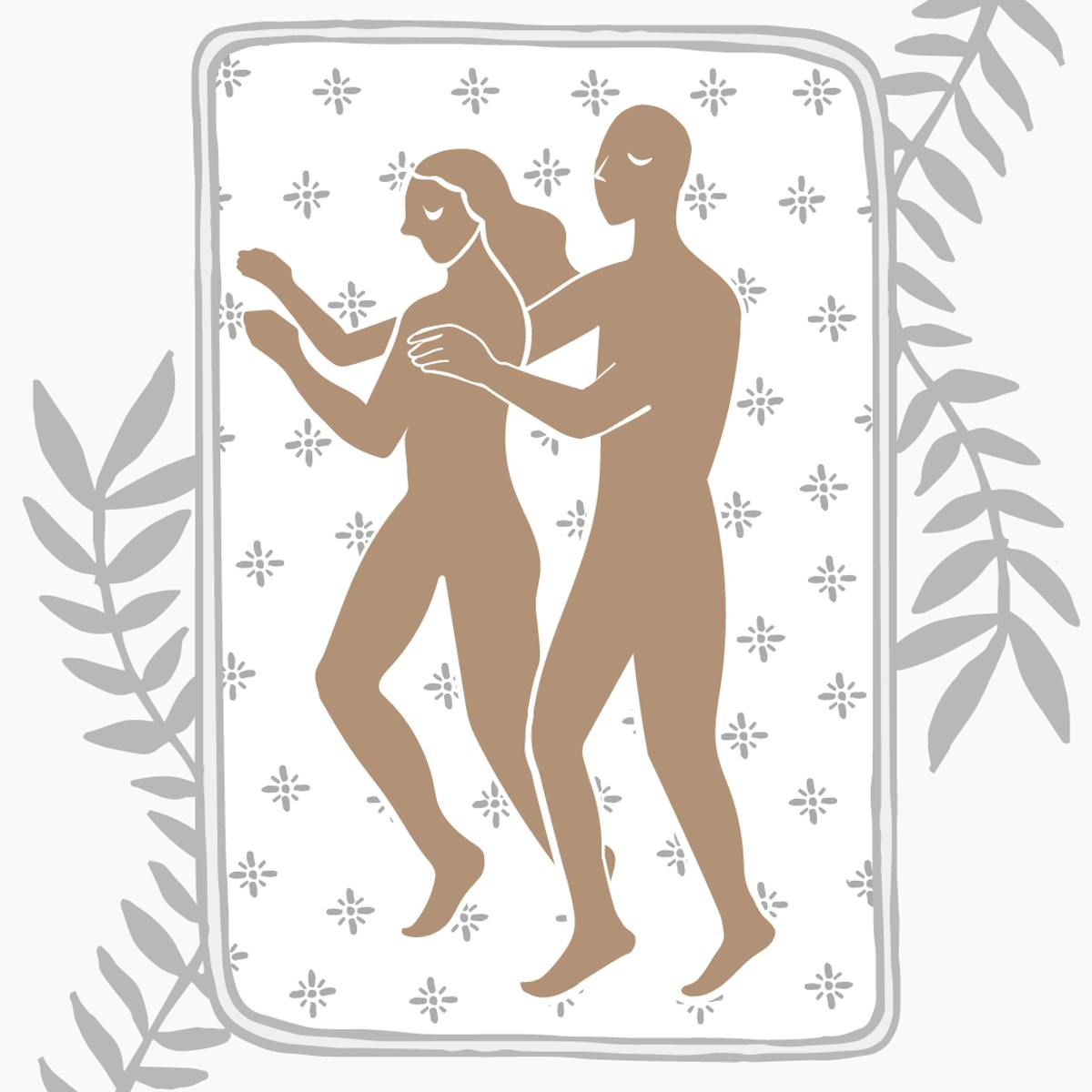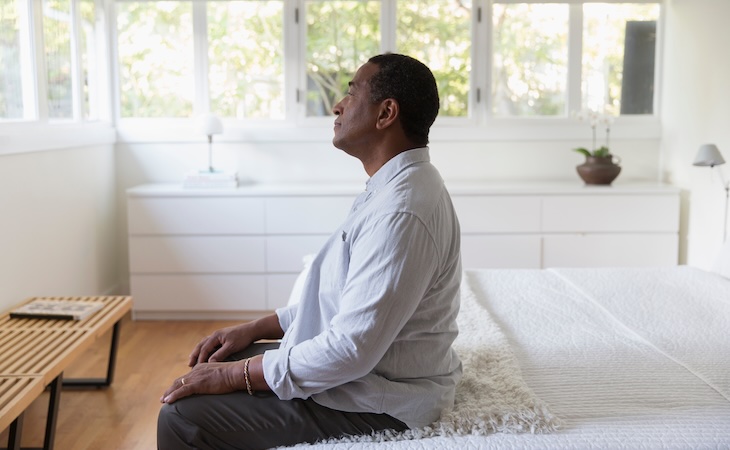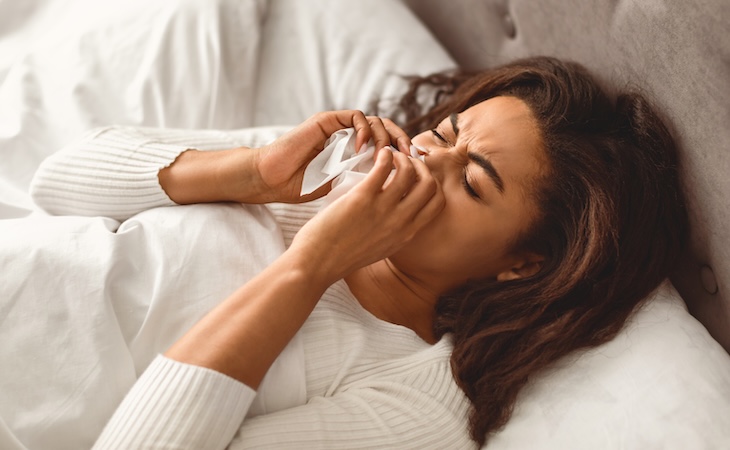It’s well known that sex can help you sleep better. [4] But did you know that good old-fashioned cuddling can help give you a good night’s rest—and even support your health and well-being?
Even if you knew that, you may not know that cuddling a pet, real or stuffed, or even a favorite blanket, can have the same effect as cuddling with a human. [5] It’s true!
Read on to learn how cuddling can improve your sleep, support your health, and make you a happier person. Yes, it’s that effective. Plus, find out what the best cuddle positions for sleeping are so you can reap the benefits.
Sleep and health benefits of cuddling
You might say cuddling is a gift that keeps on giving right back to you. Consider these six ways cuddling can support your sleep and health:
1. Relieves stress
Cuddling has been shown to release oxytocin in the brain. Commonly known as the “love hormone” or “cuddle chemical,” oxytocin calms you and relieves stress—a major reason why people struggle to fall and stay asleep. [6] Oxytocin helps reduce the stress hormone cortisol so you can snooze more easily. [7]
2. Lowers blood pressure
“Cuddling for even minutes reduces systolic and diastolic blood pressure,” says Los Angeles-based psychologist Barbara Santini. [1] “Unhealthy blood pressure levels, especially at night, increase cardiovascular risk, resulting in insomnia and sleep apnea.” [8, 9]
One couples study found that simply holding hands for 10 minutes, followed by a 20-second hug, lowered blood pressure. [10] Another study found that more frequent hugging can both lower blood pressure and increase oxytocin. [11]
3. Eases pain
Cuddling can do more than provide emotional support after an injury. By releasing oxytocin, it can block pain messages to your brain. Cuddling can have similar effects as therapeutic touch, also known as healing touch, an alternative medicine practice aimed at balancing energy within the body to ease pain and stress. [12]
It involves lightly touching and passing one’s hands over the patient’s body. Even in people with fibromyalgia, therapeutic touch has been found to significantly reduce pain. [13] It can even increase dopamine levels, further supporting pain relief. [14]
4. Improves mood
Massage techniques similar to cuddling, such as stroking and squeezing, have been found to increase dopamine and serotonin, helping ease anxiety and reduce feelings of depression and hostility. [15] Serotonin also regulates your sleep-wake cycle, notes Santini. Hence, healthy levels of this hormone in your body can make you sleep better. [16]
5. Boosts immunity
Feeling happy and safe, the way cuddling makes us feel, helps your brain produce optimal levels of oxytocin and serotonin, which also helps strengthen your immune system. [1, 17] One study found that hugging and cuddling in bed may actually protect you against the common cold. [18]
6. Increases relationship satisfaction
Cuddling isn’t just something romantic you do with your partner: It can actually benefit your relationship. Research finds that couples who cuddle not only tend to stay together but to be happier and healthier too. [19] This makes sense when you consider cuddling improves your mood and relieves physical pain, stress, and anxiety—any of which can stand between partners in a relationship.
Couples who increase their cuddling report higher levels of satisfaction with their relationship. Their affection also makes it less likely they’ll experience sleep disturbances. [20]

Best cuddling positions for sleeping
Couples sleep together in all sorts of configurations. Those who cuddle typically follow a few traditional styles.
“Spooning” is when partners sleep on their side, with one “outside spoon” wrapped around the other “inside spoon.” Then there’s a face-to-face “pretzel” cuddle with arms and legs entwined—a cuddle position especially popular with newer couples.
There’s also the back-to-back kissers cuddle with only partners’ backsides touching. The “leg hug” is common with longer-term couples. Their legs or feet touch, but not so much their bodies.
Of course, there’s also the nuzzle, with one partner’s head on the other’s chest. Really there are so many ways to cuddle that the best part may be in sampling a variety of them.
Do you love cuddling all night long—but your partner hates it? Check out our article on the common sleep problems couples face to learn how to compromise so you can still enjoy cuddling without upsetting your relationship. We’ve also put together our top tips for being a better sleep partner.
Cuddling with a stuffed animal or pet
Some folks simply can’t cuddle with their bed partners because they’re hot sleepers. Cuddling would actually prevent them from falling asleep comfortably.
For them, “a good alternative is cuddling with a stuffed animal or the like,” says Victoria Wildhorn, sleep health content specialist at Mattress Clarity. “This will give you the same warm and safety effect as cuddling with another person would but without the unnecessary heat.”
Katie Ziskind, licensed marriage and family therapist and owner of Connecticut-based Wisdom Within Counseling, explains that maintaining an item to cuddle with as an adult can help you get a good night’s sleep. “If you are an adult and you have a favorite stuffed animal or a favorite blanket, cuddling with this before you go to bed at night has been shown to promote more restful sleep,” she says.
Cuddling with a pet can be beneficial to sleep too. Their heartbeat and warmth foster the same feelings of safety, security, and love you’d get from a human cuddle partner.
What seems to matter most when it comes to cuddling is that we cuddle, not necessarily whom or what we cuddle.
“Having something familiar to you calms your nervous system and lowers anxiety,” says Ziskind. “For some people, they are cuddling with their dog or cat. For others, they are cuddling with a stuffed animal. Other people like to cuddle with a person.”
The bottom line: “We are creatures that like to have comfort, and comfort is totally OK no matter how old you are,” says Ziskind. “The most important thing is to know how you need comfort and what you like for comfort and be confident about that.”
Best mattress for cuddling
You might enjoy cuddling all night, but sleeping on your side face-to-face with your partner or wrapped up like spoons can lead to achy hips and shoulders. Choosing a softer mattress, made from latex or foam, or an innerspring mattress with a plush pillow top, will allow your joints to sink in a bit and relieve the pressure.
Saatva offers a variety of latex, memory foam, and pillow top mattresses that are excellent for cuddling. Check out our selection of high-quality mattresses or take our online mattress quiz to find out which one is right for you and your partner.
References
- Light, K. C., Grewen, K. M., & Amico, J. A. (2005). More frequent partner hugs and higher oxytocin levels are linked to lower blood pressure and heart rate in premenopausal women. Biological psychology, 69(1), 5–21. https://doi.org/10.1016/j.biopsycho.2004.11.002
- “Can You Kiss and Hug Your Way to Better Health? Research Says Yes. – Penn Medicine.” 8 Jan. 2018. https://www.pennmedicine.org/updates/blogs/health-and-wellness/2018/february/affection
- Goodin, B. R., Ness, T. J., & Robbins, M. T. (2015). Oxytocin – a multifunctional analgesic for chronic deep tissue pain. Current pharmaceutical design, 21(7), 906–913. https://doi.org/10.2174/1381612820666141027111843
- Lastella, M., O’Mullan, C., Paterson, J. L., & Reynolds, A. C. (2019). Sex and Sleep: Perceptions of Sex as a Sleep Promoting Behavior in the General Adult Population. Frontiers in public health, 7, 33. https://doi.org/10.3389/fpubh.2019.00033
- Krahn, L. E., Tovar, M. D., & Miller, B. (2015). Are Pets in the Bedroom a Problem?. Mayo Clinic proceedings, 90(12), 1663–1665. https://doi.org/10.1016/j.mayocp.2015.08.012
- McQuaid, R. J., McInnis, O. A., Paric, A., Al-Yawer, F., Matheson, K., & Anisman, H. (2016). Relations between plasma oxytocin and cortisol: The stress buffering role of social support. Neurobiology of stress, 3, 52–60. https://doi.org/10.1016/j.ynstr.2016.01.001
- Cay, M., Ucar, C., Senol, D., Cevirgen, F., Ozbag, D., Altay, Z., & Yildiz, S. (2018). Effect of increase in cortisol level due to stress in healthy young individuals on dynamic and static balance scores. Northern clinics of Istanbul, 5(4), 295–301. https://doi.org/10.14744/nci.2017.42103
- Bazzano LA, Khan Z, Reynolds K, He J. Effect of nocturnal nasal continuous positive airway pressure on blood pressure in obstructive sleep apnea. Hypertension.2007;50:417–423.https://doi.org/10.1161/HYPERTENSIONAHA.106.085175
- Liu, D., Yu, C., Huang, K., Thomas, S., Yang, W., Liu, S., & Kuang, J. (2022). The Association between Hypertension and Insomnia: A Bidirectional Meta-Analysis of Prospective Cohort Studies. International journal of hypertension, 2022, 4476905. https://doi.org/10.1155/2022/4476905
- Grewen, K. M., Anderson, B. J., Girdler, S. S., & Light, K. C. (2003). Warm partner contact is related to lower cardiovascular reactivity. Behavioral medicine (Washington, D.C.), 29(3), 123–130. https://doi.org/10.1080/08964280309596065
- Light, K. C., Grewen, K. M., & Amico, J. A. (2005). More frequent partner hugs and higher oxytocin levels are linked to lower blood pressure and heart rate in premenopausal women. Biological psychology, 69(1), 5–21. https://doi.org/10.1016/j.biopsycho.2004.11.002
- 2 Feb. 2011. https://www.cancer.gov/publications/dictionaries/cancer-terms/def/therapeutic-touch
- Denison B. (2004). Touch the pain away: new research on therapeutic touch and persons with fibromyalgia syndrome. Holistic nursing practice, 18(3), 142–151. https://doi.org/10.1097/00004650-200405000-00006
- Wood P. B. (2008). Role of central dopamine in pain and analgesia. Expert review of neurotherapeutics, 8(5), 781–797. https://doi.org/10.1586/14737175.8.5.781
- Hernandez-Reif, M., Ironson, G., Field, T., Hurley, J., Katz, G., Diego, M., Weiss, S., Fletcher, M. A., Schanberg, S., Kuhn, C., & Burman, I. (2004). Breast cancer patients have improved immune and neuroendocrine functions following massage therapy. Journal of psychosomatic research, 57(1), 45–52. https://doi.org/10.1016/S0022-3999(03)00500-2
- Cleveland Clinic. Serotonin. https://my.clevelandclinic.org/health/articles/22572-serotonin
- Mössner, R., & Lesch, K. P. (1998). Role of serotonin in the immune system and in neuroimmune interactions. Brain, behavior, and immunity, 12(4), 249–271. https://doi.org/10.1006/brbi.1998.0532
- Cohen, S., Janicki-Deverts, D., Turner, R. B., & Doyle, W. J. (2015). Does hugging provide stress-buffering social support? A study of susceptibility to upper respiratory infection and illness. Psychological science, 26(2), 135–147. https://doi.org/10.1177/0956797614559284
- Van Raalte, L. J., Floyd, K., & Mongeau, P. A. (2021). The Effects of Cuddling on Relational Quality for Married Couples: A Longitudinal Investigation. Western Journal of Communication, 85(1), 61–82. https://doi.org/10.1080/10570314.2019.1667021
- Cikara, A. (2019). Big spoon or little spoon: Relations of couples’ attachment styles to cuddling, affection, sleep, and relationship satisfaction. Auburn University. https://etd.auburn.edu//handle/10415/6666










